My enchantment began on a Saturday morning, shortly before solstice and not long after I’d moved from Anchorage’s lowlands to the city’s Hillside area. Lolling in bed, I glanced outside. And there, before me, were several black-capped chickadees flitting about a backyard spruce. Wonderful, I thought. Here’s a chance to meet some of my new neighbors. Inspired by their presence, I put a bird-feeder on the middle deck, where it could be easily observed from the living and dining rooms. My first-ever feeder wasn’t much to look at: an old, slightly bent baking pan. Still, it held plenty of seeds and sat nicely on the railing. Nothing happened that first day. But Sunday the birds returned. Seated at the dining room table, I watched a tiny, fluffy, winged creature land on the pan.
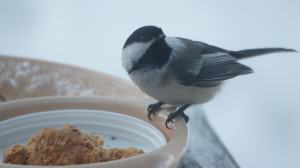
The chickadee grabbed a seed and zoomed off to a nearby tree. Then in flashed another. And a third. For each the routine was similar: dart in, look around, peck at the tray, grab a seed, look around some more, and dart back out. Nervous little creatures, full of bright energy, they somehow penetrated the toughened shell of this former sports reporter and touched my heart. I laughed at their antics and felt an all-too-rare childlike fascination.
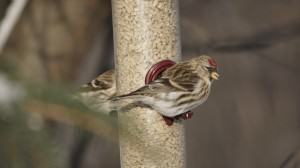
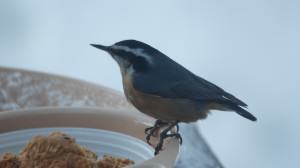
Within days, the chickadees were joined by several other species, most of which I’d never seen (or noticed) before: red-breasted nuthatch, common redpoll, pine siskin, pine grosbeak, downy woodpecker. And what started as mere curiosity bloomed into a consuming passion. I found myself roaming bookstores in search of birding guidebooks, spontaneously exchanging bird descriptions with a stranger, and purchasing fifty-pound bags of seeds.
All of this seemed very strange to a forty-four-year-old who had never been intrigued by birds (except for charismatic raptors) and previously judged bird watchers to be rather odd sorts. I didn’t know what it meant, except that a door had opened.
And I passed through…
I recount this encounter from the early 1990s because it became a turning point in my life. In the years since, birds have enriched my life in unexpected ways, including—and perhaps especially—they add cheer to my days during Alaska’s longest and harshest season.
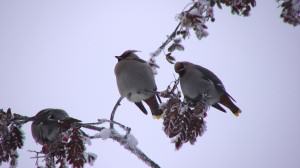
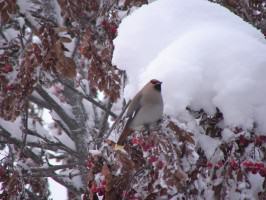
Winters in America’s far north can be hard on a person, even one living in the city, along the relatively mild coast of Southcentral Alaska. Here in Anchorage, it’s not the cold that’s a problem (in January, our coldest month, the average high and low are 22° and 8° Fahrenheit, respectively), nor the snowfall (mid-winter rains are more depressing than a foot or two of snow). The biggest problem, it seems, is darkness. And one of the best solutions, as I’ll describe below, seems to be getting outdoors and paying attention to the brightening presence of birds and their voices.
Long hours of darkness wear on many Alaskans, even in Anchorage, which on the winter solstice receives slightly less than 5½ hours of daylight. And from late November to late January, nine weeks in all, we get less than seven daylight hours. (By the time this is posted in late February, we’ll be relishing nearly ten hours of daylight, with hints of the longer and brighter days at the end of winter’s long, dark tunnel, the spring equinox now less than a month away.)
Making matters worse are the abundance of heavily overcast days, which in my journals I frequently describe as “dreary.”
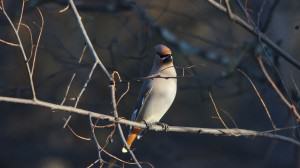
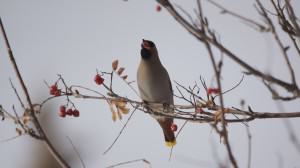
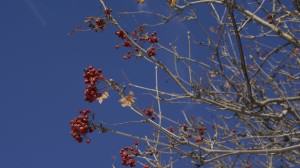
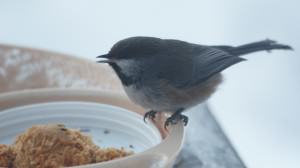
I simply cannot imagine living in the arctic, with daily light measured in minutes or not at all, for weeks or even months at a time. I’m amazed that people can survive, let alone thrive, along Alaska’s northern coast, where, for instance, the community of Barrow goes more than two months without seeing the sun (Nov. 20 through Jan. 23).
Based on my own experience and conversations with many friends and acquaintances, I feel safe in saying that winter’s darkness tends to take a cumulative toll, at least for those of us who grew up in more southerly locales and moved to Alaska as adults. After 15, 20, or 25 years of northern life, extended darkness weighs heavier on people, especially those who can’t easily get outdoors during the season’s short days. Or maybe it’s simply part of the aging process; one study conducted in Fairbanks concluded that seasonal affective disorder, or SAD, was more prevalent among people older than 40.
Looking back, it seems I somehow intuitively recognized my personal need for substantial daily winter doses of sunshine soon after moving from Southern California to Anchorage in February 1982, even if thick layers of clouds dimmed that natural light. Though I kept the long and sometimes crazy hours of a sports writer my first years in Alaska, I made it a point, whenever possible, to get outside during the day’s brighter hours, preferably for an hour or more.
Scheduling outdoor time became easier in the early 1990s, after I’d chosen the life of a freelance nature writer. It became part of my self-imposed job description to spend time “out in nature,” whatever the season or weather.
Not coincidentally, perhaps, it was also about this time that I discovered songbirds—in the darkest depths of winter, no less. That personal discovery, and my newfound passion for birds, was (as I note above) in turn tied to a move to Anchorage’s Hillside area (I’ve described that relocation in Living with Wildness: An Alaskan Odyssey and also my first TNOC posting, “Rediscovering Wildness—and Finding the ‘Wild Man’—in Alaska’s Urban Center”.
Following my life-changing introduction to the neighborhood chickadees, birds became another reason for me to more closely explore Anchorage’s landscape, throughout the year. And because not many birds stick around during winter—at least in large numbers—I quickly learned the more common resident species.
Anchorage’s Christmas Bird Count (CBC) participants have recorded as many as 52 species, but less than a dozen are likely to be regularly observed at feeders or along the city’s trails. And while a handful of raptors and a few water birds inhabit the city in winter, my favorites remain songbirds, especially the ones drawn into feeders, which I’ve been able to study and admire up close.
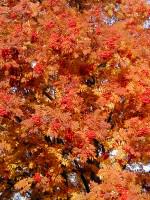
Both at home, as a feeder watcher, and on my walks (and occasional skis), it soon became part of my routine to look for, and listen to, my avian neighbors. And this became another way, an important way, that I could endure—or, better yet, embrace and occasionally delight in—Anchorage’s six- to seven-month-long winter season.
Besides the common feeder birds, a few other passerine species have brought me special delight: brown creepers, which often hang out with chickadees and nuthatches but rarely, in my experience, visit feeders; American dippers, impressive in their frigid, depth-of-winter swims; ravens, which in their raucous way enliven the city, many of them visiting during the daylight hours to hunt food and play, then head for the hills to roost for the night; and bohemian waxwings, which don’t stay the entire winter but help to brighten the city during winter’s darkest days.
The presence of waxwings seems especially worth mentioning here, not only because they bring such pleasure and amazement to many of us human residents of Anchorage, but because their temporary occupation of the city in enormous numbers is a relatively recent phenomenon that’s directly tied to an increase of other, introduced species. This local connection is another example of the issues that Matt Palmer explored in his TNOC posting, “Our Changing Urban Nature: Time to Embrace Exotic Species? (Or at Least Some of Them)”.
Bohemian waxwings are rarely, if ever, seen in Anchorage’s highly developed downtown and midtown areas from spring through fall. But in early winter—usually sometime in mid- to late October—they begin to appear, initially in small and easy to overlook numbers. But by year’s end, thousands of them inhabit the city.
It’s remarkable, really, that birds which normally avoid Alaska’s urban center suddenly invade it in such huge numbers. What draws them here (as you might expect) is food. In recent decades, locals have planted hundreds, perhaps thousands, of fruit-bearing trees in yards and along Anchorage’s streets. Over time, waxwings learned that when food becomes scarce in their normal habitats—the forested lands beyond Anchorage—there is still plenty to eat in the city. Singly, in pairs, and small groups, these wide-ranging “gypsy birds” head into town for an amazing feast.
Roaming the city, they swoop and dive in synchronized flight while they move from neighborhood to neighborhood and street to street, descending on yards and greenbelts to strip ornamental trees of their fruit: mountain ash berries, chokecherries, crab apples.
As the days and weeks pass, small groups coalesce into ever-larger flocks, until by December multitudes of the birds swirl through the sky. A few years ago, participants in Anchorage’s CBC tallied more than 22,000 waxwings. One serious birder told me he’s seen as many as 3,000 in a single flock and knew of others who’ve watched 5,000 or more in flight.
Once the food is gone, the birds depart. Most years, Anchorage is again largely waxwing free by late January or early February.
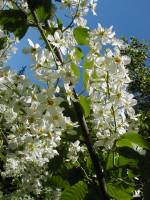
At least one group of the fruiting trees that pull in waxwings, all commonly called chokecherries, has proved itself a troublesome invasive. The European bird cherry or Mayday tree has especially become a problem. Local foresting experts say this chokecherry is displacing native vegetation, pushing out understory plants like Canadian dogwood, willow, and alder. In 2011, municipal forester Scott Stringer told local TV station KTUU that the Mayday tree “has taken over the entire creek corridor along Chester Creek,” one of the main streams that pass through Anchorage.
Besides displacing indigenous plants, chokecherry trees have killed moose. As reported in the Anchorage Daily News in February 2011, a state wildlife veterinarian determined that three moose calves had died from cyanide poisoning after eating the frozen buds, branches, and berries of Mayday trees. It’s likely that some portion of other winter-kill moose have similarly been poisoned over the years, but the attention given to those particular calves’ deaths, plus the increased and substantial evidence that chokecherries are supplanting native species, has led to an effort to control them. Besides agency efforts, the public has been recruited. During the summer of 2011, for example, more than 100 volunteers participated in a “weed smackdown” to remove chokecherries from Anchorage’s Valley of the Moon Park (the event reported by KTUU).
Given the chokecherries’ popularity with both waxwings and humans (in early summer the trees have beautiful, fragrant white flowers and they ornament many yards around the city), it’s likely the chokecherry is here to stay. But forestry experts hope that continued removal programs—including occasional smackdowns—and efforts to get nurseries and homeowners to stop planting new trees will limit the invasives’ spread.
However much chokecherries are cut back, there are enough other fruiting trees spread around town to keep waxwings returning to our city.
There’s one way, in particular, that Anchorage’s winter birds brighten my days: with their voices.
Even when I can’t see my avian neighbors, as sometimes when walking through the woods, I can usually hear them. In fact their voices are often what alert me to their presence. Every day when I step outside my house, whether it’s to retrieve the newspaper or mail, to shovel snow, or go walking, I listen for birds. Whether it’s the chatter of black-capped and boreal chickadees, the nasally yank, yank, yank of nuthatches, the chirping of redpolls, the warbled songs of grosbeaks, the cawing of ravens, or the soft trills of waxwings, their voices add some measure of brightness to my day and this is no small thing.
There are times when I’ll hear the faint voice of a chickadee or redpoll or waxwing, and stop to see if I can find the bird. And in my stopping I’ll begin to see several of them, occasionally (with redpolls and waxwings) even dozens, that I hadn’t noticed only moments before, perhaps because I was lost in my own thoughts or worries or plans. And I’m reminded how even in the city we’re surrounded by wild creatures and other forms of life, which we so often ignore or take for granted.
Bird song is more likely to get our attention in spring and summer, when dozens of species mark the nesting season with their loud and often lovely voices. But though less abundant and less diverse in winter, the songs and chatter remain important to me and, I’m sure, to others who pay attention. I was reminded of this while reading Tim Beatley’s TNOC posting, “Celebrating the Natural Soundscapes in Winter,” which inspired me to write a commentary for a local online news journal, the Alaska Dispatch, “The noise and the fury: Snowmachines in Kincaid Park?”.
Our cities have plenty of obnoxious noise. But they also have their share of pleasing, relaxing, and delightful sounds too, most of them, in my experience, provided by nature.
Here I’ll return one more time to the waxwings and their brightening influence.
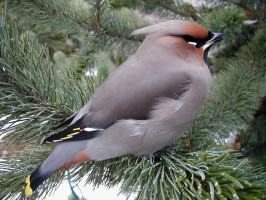
The presence of breathtakingly huge flocks, and their sudden descent upon neighborhoods, is only one of several great delights that bohemian waxwings bring to Anchorage residents. They are among the handsomest birds to inhabit the far north, their bodies mostly covered by a gray suit of silky feathers, tinted russet about the head. Their feathered finery is further decorated by a tail brightly edged in yellow, a black eye mask, and white-striped wings that bear the small red “wax” bars that give the birds their name.
Beyond that, waxwings sing and talk among themselves in soft, reedy trills that are pleasing to the human ear. When a flock visits the neighborhood, I often stand silently a while, simply to enjoy the music in their voices.
It is an amazing and unforgettable thing, to stand among hundreds, perhaps thousands, of birds as they swirl through one’s own neighborhood, trilling softly yet brightly. To be surrounded by such abundant, spirited life is an absolute treat, a flash of brilliance and hopefulness during the north’s longest, harshest season. No wonder, then, that the waxwings’ short but intense presence here—and my increased awareness of them—has become one of my great pleasures, and comforts, during Alaska’s long winters.
Bill Sherwonit
Anchorage, Alaska, USA


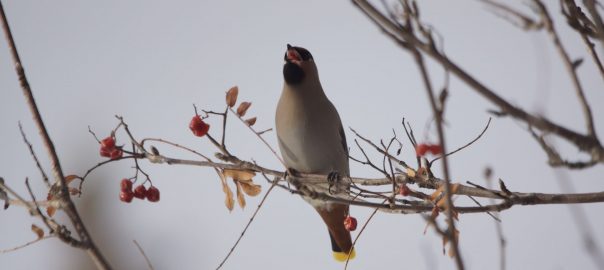
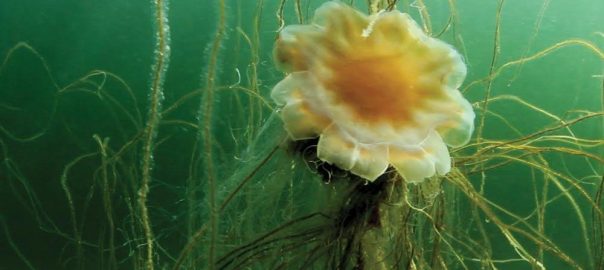
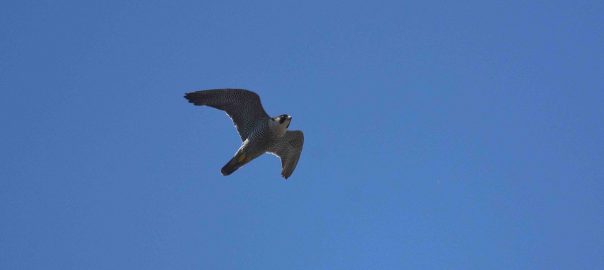

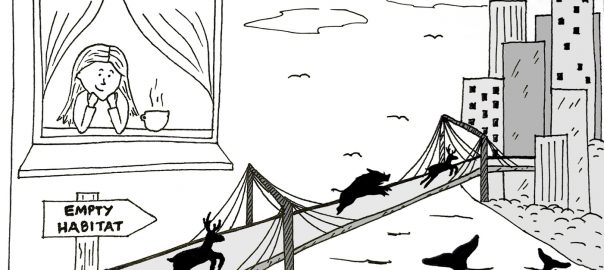
Leave a Reply